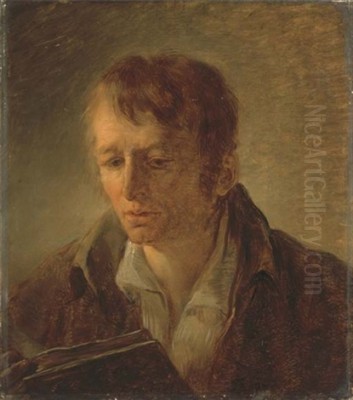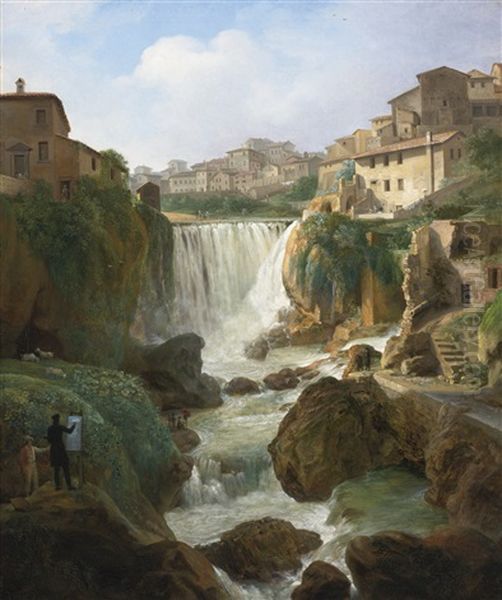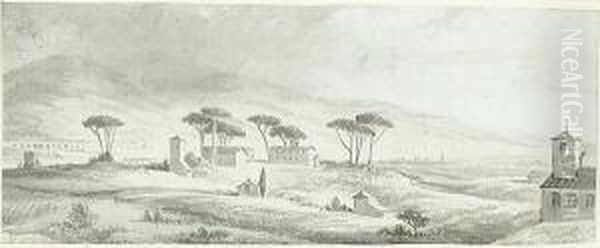
Simon-Joseph-Alexandre Clément Denis, a name that resonates with the nuanced transition of European landscape painting from the late 18th to the early 19th century, stands as a significant, if sometimes overlooked, figure. Born in the bustling artistic hub of Antwerp on April 14, 1755, and passing away in the sun-drenched city of Naples on January 1, 1813, Denis carved a unique path, primarily active in Italy, where his keen observational skills and innovative approach to landscape left an indelible mark. His work, characterized by a sensitive rendering of light and atmosphere, particularly in his oil sketches, positions him as a vital link between the established traditions of classical landscape and the burgeoning Romantic sensibility, as well as an important precursor to the Barbizon School and Impressionism.
Early Life and Artistic Formation in Antwerp
Denis's artistic journey began in Antwerp, a city with a rich legacy of painting, particularly in landscape and genre scenes, tracing back to masters like Pieter Bruegel the Elder and Peter Paul Rubens. He undertook his initial training under the guidance of Hendrik-Jozef Antonissen, a respected painter known for his landscapes and animal subjects. Antonissen's tutelage would have instilled in Denis a solid foundation in the Flemish tradition, which emphasized meticulous detail, a rich palette, and a deep appreciation for the natural world. This grounding in precise observation and technical skill would serve Denis well throughout his career, even as his style evolved.
During these formative years, Denis also came under the influence of Balthasar Paul Ommeganck, another prominent Antwerp painter celebrated for his idyllic landscapes often populated with sheep and cattle. Ommeganck's work, with its careful attention to animal anatomy and the textures of nature, likely further refined Denis's ability to depict fauna and flora with convincing realism. The artistic environment of Antwerp, though perhaps past its Golden Age zenith, still provided a stimulating atmosphere for a young artist eager to learn the craft of painting. The emphasis on direct observation, a hallmark of Flemish art, was a crucial element that Denis would carry with him and adapt in new and innovative ways.
The Parisian Sojourn and Royal Favor

Around 1775, seeking broader horizons and new opportunities, Simon Denis made the pivotal decision to move to Paris. The French capital was, at this time, the undisputed center of the European art world, a vibrant crucible of artistic innovation and patronage. It was here that Denis's talent began to gain wider recognition, significantly aided by the influential art dealer and connoisseur Jean-Baptiste-Pierre Le Brun. Le Brun, husband of the celebrated portraitist Élisabeth Vigée Le Brun, was a key figure in the Parisian art market, known for his discerning eye and his ability to promote promising artists.
Through Le Brun's advocacy, Denis's work came to the attention of the French royal court, and by the 1780s, he had garnered favor with King Louis XVI. This royal patronage was a significant endorsement, opening doors and enhancing his reputation. While in Paris, Denis would have been exposed to a diverse range of artistic currents, from the lingering elegance of the Rococo, exemplified by artists like Jean-Honoré Fragonard, to the rising tide of Neoclassicism championed by Jacques-Louis David. This period in Paris was crucial for Denis, not only for the connections he made but also for the broadening of his artistic perspectives before his eventual move to Italy, the ultimate destination for landscape painters of his era.
The Roman Years: A Flourishing Career
The allure of Italy, with its classical ruins, picturesque landscapes, and legendary light, proved irresistible for Denis, as it did for countless artists before and after him. In 1786, he established himself as a resident painter in Rome, a city that would become central to his artistic development and output. Rome was a melting pot of international artists, all drawn by its rich artistic heritage and the opportunity to study firsthand the masterpieces of antiquity and the Renaissance, as well as the sublime Italian landscape itself.
A year after his arrival, in 1787, Denis married a local woman, further cementing his ties to the city. He became an active and respected member of the artistic community. His standing among his peers was recognized when he was appointed the first president of the Fondation de St. Julien des Flamands (also referred to as St. Jean des Flamands), an institution supporting artists from the Southern Netherlands in Rome. This role underscored his leadership qualities and his integration into the expatriate artistic network.

Denis’s Roman period was marked by prolific output and growing acclaim. He formed close associations with other artists, including, according to some accounts, François Marius Granet, a French painter also renowned for his depictions of Roman scenes and interiors, particularly his mastery of light. The exchange of ideas and techniques within this vibrant community undoubtedly enriched Denis's own practice. His dedication and skill were formally acknowledged in 1801 (some sources suggest 1803) when he was admitted as an academician to the prestigious Accademia di San Luca, Rome's academy of art, a significant honor that solidified his reputation as a master of his craft.
Artistic Style: Observation, Innovation, and the Italian Light
Simon Denis's artistic style is notable for its blend of meticulous Flemish observation and a burgeoning romantic sensibility, particularly evident in his treatment of the Italian landscape. He specialized in depicting trees, flowers, and animals, often with a striking realism, yet his compositions and atmospheric effects frequently transcended the purely topographical to evoke mood and emotion. While influenced by the classical landscape tradition, exemplified by artists like Claude Lorrain and Gaspard Dughet, whose idealized visions of the Roman Campagna had set a standard for generations, Denis forged his own path.
A key aspect of Denis's innovation lay in his practice of plein air (open-air) oil sketching. Working directly from nature, he captured the fleeting effects of light and weather with remarkable freshness and immediacy. These oil sketches, often executed on paper, are characterized by rapid, confident brushwork and a keen sensitivity to color and tone. They reveal his profound understanding of how light shapes form and defines atmosphere, from the crisp clarity of a sunny morning to the soft haze of dusk or the dramatic chiaroscuro of an approaching storm. This practice aligned him with contemporaries like Pierre-Henri de Valenciennes, another pioneer of plein air oil sketching in Italy, whose theoretical writings and painted studies advocated for direct observation as essential for landscape painters.
While his finished studio paintings were more polished and often incorporated narrative or pastoral elements, it is these oil sketches that are often considered his most groundbreaking contributions. They anticipate the concerns of later 19th-century landscape movements, such as the Barbizon School in France, with painters like Jean-Baptiste-Camille Corot (who also painted extensively in Italy) and Théodore Rousseau, and ultimately, the Impressionists. Denis's ability to capture the specific character of the Italian light and landscape, without sacrificing a sense of poetic beauty, distinguishes his work.
Masterpieces and Signature Themes: The Cascades of Tivoli and Beyond
Among Simon Denis's most celebrated works is "View of the Cascades at Tivoli," a subject he painted more than once, often featuring his close acquaintance, the renowned portraitist Élisabeth Vigée Le Brun. One notable version depicts Madame Vigée Le Brun and her daughter, Julie, sketching beneath the shade of trees, with the dramatic waterfalls cascading in the background. This painting is a masterful blend of landscape and genre, capturing not only the sublime beauty of the Tivoli site but also a moment of artistic sociability and the contemporary practice of sketching outdoors. The figures are gracefully integrated into the lush, verdant setting, and Denis’s skill in rendering the textures of foliage, the spray of the water, and the interplay of light and shadow is fully evident.
His oeuvre extended beyond Tivoli to encompass a wide range of Italian scenery. Views of the Roman Campagna, with its ancient aqueducts and umbrella pines, were a recurring theme, allowing him to explore expansive vistas and the unique atmospheric conditions of the region. He also painted scenes around Naples, a city he would later call home, capturing its dramatic coastline and the ever-present silhouette of Mount Vesuvius. These works often demonstrate his ability to create a sense of depth and space, drawing the viewer into the landscape.
Beyond these larger, more finished compositions, his numerous oil sketches stand as a significant body of work in their own right. Studies of individual trees, cloud formations, rock faces, or panoramic glimpses of the countryside reveal his intense scrutiny of nature and his experimental approach to capturing its essence. These sketches, often characterized by their vibrant color and dynamic brushwork, possess an intimacy and spontaneity that is highly appealing to modern eyes. They underscore his role as an artist deeply engaged with the direct experience of the landscape, a practice that was still relatively novel for oil painting at the time, though artists like the Welshman Thomas Jones had also made remarkable small oil sketches in Italy a decade or so earlier.
Connections and Contemporaries: A Network of Artists
Simon Denis's career unfolded within a rich tapestry of artistic connections. His relationship with Jean-Baptiste-Pierre Le Brun in Paris was instrumental in his early success. Le Brun's wife, Élisabeth Vigée Le Brun, became a significant figure in Denis's life, especially during their time in Italy. Their friendship is well-documented, with Vigée Le Brun mentioning him in her memoirs and Denis frequently including her in his landscape paintings, such as the aforementioned "View of the Cascades at Tivoli." They shared excursions to picturesque sites, and their mutual respect as artists is evident. This connection highlights the social and professional networks that sustained artists, particularly those working abroad.
In Rome, Denis was part of an international community. His contemporary, Pierre-Henri de Valenciennes, was a pivotal figure in the development of landscape painting, advocating for the academic legitimacy of the genre and the importance of plein air studies. While their styles differed, both artists contributed significantly to the practice of painting landscapes directly from nature in oil. Other landscape painters active in Italy during this period included Jakob Philipp Hackert, a German artist who enjoyed immense success in Naples, and Abraham-Louis-Rodolphe Ducros, a Swiss painter known for his large, dramatic watercolors of Italian scenes.
The broader artistic context also included established masters whose influence lingered, such as Claude-Joseph Vernet, famed for his seascapes and Italianate views, and Hubert Robert, known for his picturesque depictions of ruins. While Denis's approach was more naturalistic than Robert's often romanticized caprices, the shared interest in Italy's scenic beauty and historical resonance is clear. He would also have been aware of the work of British artists on the Grand Tour, like Joseph Wright of Derby, who famously painted eruptions of Vesuvius. Denis's interactions, whether direct or indirect, with this diverse group of artists contributed to the evolving discourse on landscape painting at the turn of the century. His unique Flemish sensibility, combined with his experiences in Paris and Rome, allowed him to synthesize various influences into a distinctive artistic voice.
The Neapolitan Finale: Court Painter to Joseph Bonaparte
In 1806, Simon Denis's career took another significant turn when he was appointed court painter to Joseph Bonaparte, Napoleon's elder brother, who had been installed as King of Naples. This prestigious appointment marked a new phase in Denis's life, relocating him from Rome to the vibrant southern Italian city. As court painter, his responsibilities would have included producing landscapes and possibly scenes documenting the King's travels or estates, contributing to the cultural image of the Napoleonic regime in Naples.
Working in Naples offered Denis new landscapes to explore, from the dramatic Bay of Naples and the looming presence of Vesuvius to the surrounding fertile countryside. His paintings from this period likely continued to showcase his mastery of light and atmosphere, now applied to the specific scenery of the Neapolitan region. This royal patronage provided him with financial stability and further recognition, placing him at the center of artistic life in Naples.
Unfortunately, this final chapter of his career was relatively short. Simon-Joseph-Alexandre Clément Denis passed away in Naples on January 1, 1813, at the age of 57. He left behind a significant body of work that captured the beauty of Italy through a uniquely observant and sensitive artistic lens. His tenure in Naples, though brief, capped a career that had taken him from the artistic centers of Antwerp and Paris to the heart of the classical world in Rome and finally to the lively court of Naples.
Legacy and Reappraisal: From Obscurity to Recognition
Following his death, Simon Denis's reputation, like that of many artists of his era who did not fit neatly into the grand narratives of Neoclassicism or full-blown Romanticism, experienced a period of relative obscurity. While he was respected during his lifetime, particularly for his finished landscapes, the more intimate and innovative aspects of his work, especially his plein air oil sketches, were not widely appreciated until much later. The prevailing taste in the 19th century often favored more highly finished and historically significant subjects.
However, the late 20th and early 21st centuries have witnessed a significant reappraisal of artists like Denis. The growing scholarly interest in the history of plein air painting and the precursors to Impressionism has brought renewed attention to his oil sketches. These works are now recognized for their freshness, their bold handling of paint, and their remarkable sensitivity to the nuances of light and atmosphere. Art historians acknowledge his role in the development of naturalistic landscape painting and his contribution to the practice of painting outdoors, a method that would become central to many avant-garde movements of the 19th century.
His paintings are now found in the collections of major museums, including the Metropolitan Museum of Art in New York and the Nationalmuseum in Stockholm, attesting to his rediscovered importance. The art market has also reflected this renewed interest, with his works, such as "A View to the Cascades of Tivoli," achieving strong prices at auction, far exceeding initial estimates. This resurgence highlights a broader trend in art history to re-evaluate artists who worked outside the dominant academic traditions or whose innovations were ahead of their time. Denis's legacy lies in his ability to combine the meticulous tradition of his Flemish heritage with a forward-looking approach to capturing the direct experience of nature, particularly the enchanting landscapes of Italy.
Conclusion: An Enduring Vision of Italy
Simon-Joseph-Alexandre Clément Denis was an artist who skillfully navigated the artistic currents of his time, creating a body of work that remains compelling for its beauty, its technical finesse, and its innovative spirit. From his early training in Antwerp to his celebrated career in Italy, he consistently demonstrated a profound connection to the natural world. His landscapes, particularly his vibrant oil sketches made directly from nature, reveal an artist deeply attuned to the subtleties of light and atmosphere, capturing the unique character of the Italian scenery with both precision and poetry.
While his name may not be as widely known as some of his contemporaries, such as Jacques-Louis David in historical painting or even Pierre-Henri de Valenciennes in landscape theory, Denis's contribution to the evolution of landscape painting is undeniable. He stands as a key figure in the transition towards a more direct, observational approach to nature, anticipating the concerns of later 19th-century artists. His depictions of the Roman Campagna, the waterfalls at Tivoli, and the Neapolitan coast offer an enduring vision of Italy, filtered through the eyes of a gifted Flemish painter who made the Mediterranean light his own. As art history continues to uncover and celebrate the diverse talents that shaped European art, Simon Denis's star rightfully shines brighter, his work cherished for its quiet beauty and its pioneering spirit.